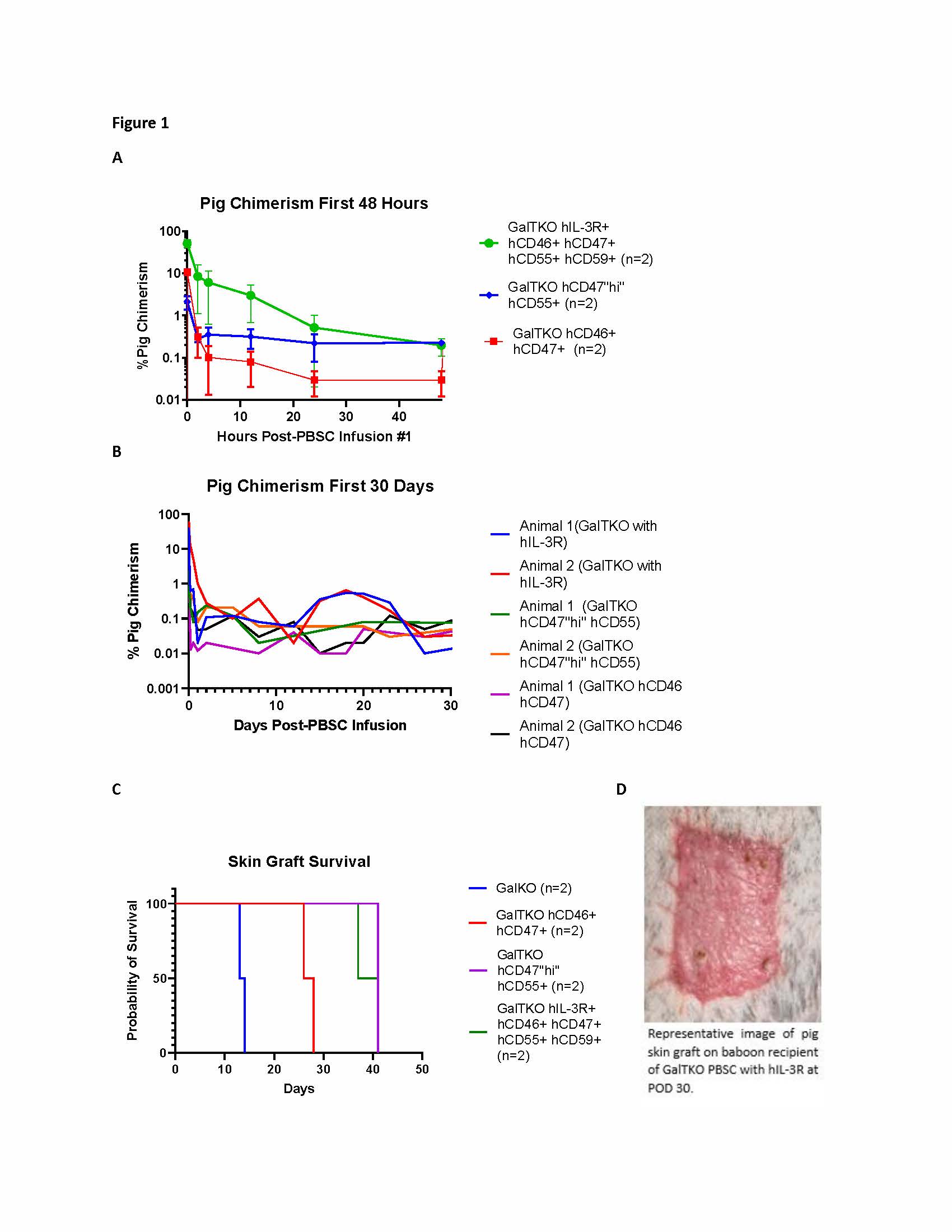Increased Baboon Chimerism After Peripheral Blood Stem Cell Infusion from a Novel GalTKO Pig with Functional Humanized Il-3 Receptor
Columbia University Irving Medical Center, New York, NY
Meeting: 2022 American Transplant Congress
Abstract number: 1524
Keywords: Gene expression, knockout, Mixed chimerism, Skin transplantation
Topic: Basic Science » Basic Science » 13 - Xenotransplantation
Session Information
Session Time: 7:00pm-8:00pm
 Presentation Time: 7:00pm-8:00pm
Presentation Time: 7:00pm-8:00pm
Location: Hynes Halls C & D
*Purpose: The purpose of this study was to investigate whether expression of a humanized IL-3 receptor (hCD123+hCD131) transgene in a GalTKO pig would improve levels and/or duration of mixed chimerism and tolerance in a pig-to-baboon xenotransplantation model.
*Methods: A novel GalTKO/hCD46/hCD47/hCD55/hCD59 transgenic, hCD123/hCD131/hCD116 knock-in pig from the Sachs herd underwent leukapheresis for peripheral blood stem cell (PBSC) donation to two P. hamadryas baboons. Baboons received non-myeloablative conditioning with total body and thymic irradiation, rituximab, ATGam, LoCD2b, and anti-CD154. Tacrolimus was given from day 0 to day 30. Porcine stem cell factor was administered up to day 28, but exogenous pig IL-3, normally given to promote porcine chimerism, was omitted. Three PBSC infusions of 1×109 mononuclear cells/kg were administered on day 0, 49, and 63 and split-thickness skin from the same donor pig was grafted on day 83. Peripheral chimerism, xeno-antibody levels and MLRs were measured by flow cytometry. Skin photographs and biopsies were used to monitor grafts.
*Results: Mobilized porcine cells were found to express the alpha chains for both human IL-3 and GM-CSF receptors, but in vitro assays demonstrated responsiveness only to human IL-3. Peripheral chimerism was elevated after infusion compared to historic controls until the 48-hour timepoint. Between day 15-23 there was an elevation in peripheral chimerism that had not been seen in previous studies using other pigs. Both animals demonstrated donor-specific hyporesponsiveness on MLR at day 30. Xeno-antibody levels remained low until skin graft rejection. Skin graft survival was to day 37 and day 41, respectively.
*Conclusions: An increase in peripheral chimerism was apparent during the first 24 hours and again at 2-3 weeks post-infusion. Increased chimerism at this timepoint is compatible with maturation of later myeloid progenitors as typically observed in allogeneic stem cell transplants. Sustained chimerism was not seen beyond day 30. Hyporesponsiveness was demonstrated in MLR and xeno-antibodies were not elicited until skin graft rejection. Skin graft survival was similar to baboons receiving PBSC from pigs with high hCD47 expression and prolonged compared to animals with low or no hCD47 expression. Our studies suggest that knocking in the hIL-3 receptor to porcine donors may help to promote sustained mixed chimerism for tolerance across the species barrier.
To cite this abstract in AMA style:
Duggan EM, Llore NP, Stern JM, Sakai H, Piegari B, Bruestle K, Hajosi D, Bhola B, Huang F, Ekanayake-Alper D, Sachs DH, Sykes M, Hawley RJ, Griesemer AD. Increased Baboon Chimerism After Peripheral Blood Stem Cell Infusion from a Novel GalTKO Pig with Functional Humanized Il-3 Receptor [abstract]. Am J Transplant. 2022; 22 (suppl 3). https://atcmeetingabstracts.com/abstract/increased-baboon-chimerism-after-peripheral-blood-stem-cell-infusion-from-a-novel-galtko-pig-with-functional-humanized-il-3-receptor/. Accessed December 25, 2025.« Back to 2022 American Transplant Congress

